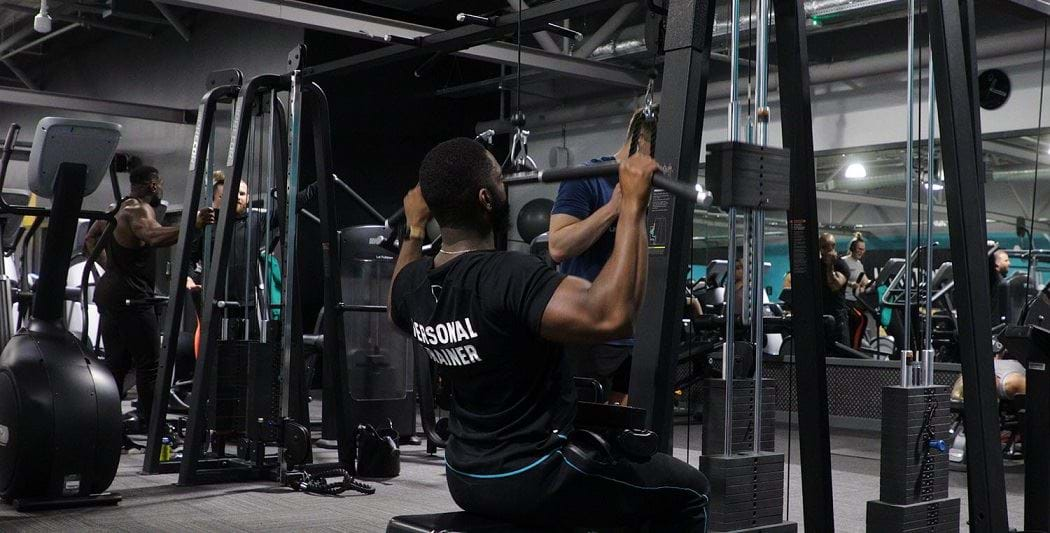Lat Pulldowns
What Is A Lat Pulldown?

The lat pulldown is a compound exercise that strengthens the back, targeting the latissimus dorsi and biceps, with further engagement from the rear delts, rhomboids and traps. Useful for both strength and hypertrophy goals, this is one of the best pulling exercises to work the back.
The convention lat pull down uses a pronated (overhand) grip, with hands placed around shoulder width apart. The wider the grip, the harder the lat pulldown will feel. There are other grip variations of the lat pulldown such as reverse grip lat pulldown and close grip lat pulldown.
The movement pattern and muscles used in the lat pulldown are similar to the pull up, however instead of pulling themselves towards the bar, the lifter pulls the bar towards their chest.
There is also a variation where the bar is pulled down behind the head towards the rear deltoids. The behind-the-neck lat pulldown creates greater scapula retraction and depression, which requires the rotator cuff to work harder to stabilise the shoulders. While this can put the rotator cuff at greater risk of injury when using too much load or incorrect form, using a light weight will help to improve strength and stability in the rotator cuffs while working the lats.
Check out some other lat pulldown variations: close grip lat pulldowns, wide grip lat pulldowns, reverse grip lat pulldowns, straight arm lat pulldowns, kneeling lat pulldowns
Commonly Asked Questions On Lat Pulldown
Lat pulldowns work the back muscles, with the latissimus dorsi (the largest muscle in the back) doing most of the work. The biceps and rear deltoids are also involved.
To use the lat pulldown machine, sit on the bench and set the pads so they sit tight on your thighs. Stand up to reach the bar with your preferred grip, then sit down with feet flat on the floor and knees secured. When pulling the bar, think about driving your elbows down and keeping your torso stable.
Lat pulldowns are a back exercise and do not strengthen the chest. To work the chest, we recommend pushing exercises like the bench press.
Behind the neck pulldowns are not necessarily bad, however it’s important to recognise that the movement does place the shoulders in an awkward position, putting the rotator cuff under pressure and potentially opening the joint to injury risks.
If you choose to perform the behind the neck pulldown opt for a lighter load that can be performed in a mid to high rep range. If you’re prone to shoulder pain, we recommend going with a conventional lat pulldown.
Lat Pulldown Tips
It’s important to perform the lat pulldown with control, rather than yanking the bar down, so that the correct muscles are targeted. Think about keeping your torso stable and pulling your elbows down and back towards your glutes, stopping when the bar reaches just below your chin and your forearms are upright. When returning the bar to the top, perform this slowly – don’t let the cable do the work!
How To Do A Lat Pulldown
Take a seat on the machine and adjust the pads so they sit tightly against your thighs.
Stand up to grip the bar with an overhand grip, hands just outside of shoulder width distance.
Hinge forward by pushing your hips back until your torso is at a 45-degree angle to your thighs.
Sit down on the bench, lean slightly back, and then pull the bar towards your upper chest by driving your elbows down and back.
Stop when the bar passes below chin height and reverse the movement by slowly extending the arms, allowing the cable to pull the bar back up.
How To Do A Behind-The-Neck Lat Pulldown
Take a seat on the machine and adjust the pads so they sit tightly against your thighs.
Stand up to grip the bar outside of shoulder width apart, using a pronated grip so that your palms are facing away from you.
Sit down on the bench and hinge slightly forward at the hips while keeping a neutral spine.
Pull the bar down and behind the head by driving your elbows back and down, stopping when the bar is around the base of your skull.
Reverse the movement by slowly extending the arms, allowing the cable to pull the bar back up.
If you’re not sure if any of the above exercises are suitable for you, please consult your doctor before you start it. Need guidance on how to perform the exercise? Ask a personal trainer at your gym.